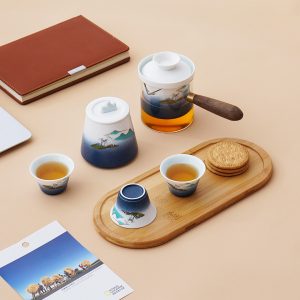What is glass made of? The wonders of glass all come down to melting sand.
Glass has become so commonplace today that it’s easy to see right through it without a second thought. It’s in our windows, on our screens, in our cabinets, and in many of the devices we interact with every day. Even though glass can be found everywhere, you may live your whole life not knowing much about how it’s made or what it’s composed of. Even if you think you know the basics, you’ve only skimmed the surface.
At a high level, glass is sand that’s been melted down and chemically transformed. If you’ve ever been to the beach, you know exactly how hot sand can get while remaining in its solid form. The kind of heat necessary to transform sand into a liquid state (eventually becoming glass) is much hotter than any sunny day. To make sand melt, you need to heat it to roughly 1700°C (3090°F), which is approximately the same temperature a space shuttle reaches as it re-enters earth’s atmosphere.
The sand commonly used to make glass is comprised of small grains of quartz crystals, made up ofmolecules of silicon dioxide, which is also known as silica. When those molecules are heated to high enough temperatures, the sand melts and loses its crystalline structure, and as it cools it gains an entirely different structure. That structure, on a molecular level, is somewhere in between a liquid and a solid. This in-between state is known as an amorphous solid, which means it has some of the crystalline structure of a solid coupled with the molecular randomness of a liquid.
Depending on the sand mixture, glass can have a variety of properties. Certain elements or chemicals mixed with sand can change glass’s color, for example. Glass’s properties can also change based on how it’s manufactured and the processes by which it’s shaped afterward. To strengthen glass, manufacturers can use thermal tempering to heat and cool it rapidly. Glass can also be strengthened chemically through an ion exchange process that makes the surface of the glass tougher.
The glass most people are familiar with is soda-lime glass, which is a combination of soda (also known as soda ash or washing soda), limestone, and sand. Although you can make glass simply by heating and then rapidly cooling silica, the manufacturing of soda-lime glass is a little more complex. By adding soda (sodium carbonate), the melting point of the sand is reduced so it can be transformed into glass at lower temperatures and save energy during manufacturing. However, adding soda to the mixture reduces its chemical durability, making it prone to dissolve when in contact with liquids. For most applications, that’s not desirable, so limestone (calcium carbonate) is also added to the mixture, which acts as a stabilizer. Once the mixture of silica, soda, and limestone is heated, it can be cooled and molded for a variety of applications.
At Corning, we know glass. We know how to strengthen it through chemical processes like ion exchange, and we know how to bend it to make optical fiber that can stretch over vast distances. Our knowledge of glass goes back more than a century, allowing us to remain on the cutting edge of research and development. From simple soda-lime to complex glass structures that enable augmented reality, glass is an adaptable, wide-ranging material. That’s why, after more than 165 years, we’re still making new discoveries.

